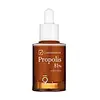What's inside
What's inside
 Key Ingredients
Key Ingredients

 Benefits
Benefits

 Concerns
Concerns

 Ingredients Side-by-side
Ingredients Side-by-side

Propolis Extract
Skin ConditioningGlycerin
HumectantButylene Glycol
HumectantNiacinamide
SmoothingGlycosyl Trehalose
Emulsion StabilisingWater
Skin ConditioningDimethicone
EmollientHydrogenated Starch Hydrolysate
HumectantSilica
AbrasivePolyglyceryl-4 Caprate
Emulsifying1,2-Hexanediol
Skin ConditioningCaprylyl Glycol
EmollientSodium Polyacrylate
AbsorbentPerilla Frutescens Leaf Extract
MaskingPortulaca Oleracea Extract
Skin ConditioningHouttuynia Cordata Extract
Skin ConditioningCamellia Sinensis Leaf Extract
AntimicrobialAllantoin
Skin ConditioningPentylene Glycol
Skin ConditioningAspalathus Linearis Extract
Skin ConditioningCommiphora Myrrha Resin Extract
Skin ConditioningYucca Schidigera Root Extract
Skin ConditioningPropolis Extract, Glycerin, Butylene Glycol, Niacinamide, Glycosyl Trehalose, Water, Dimethicone, Hydrogenated Starch Hydrolysate, Silica, Polyglyceryl-4 Caprate, 1,2-Hexanediol, Caprylyl Glycol, Sodium Polyacrylate, Perilla Frutescens Leaf Extract, Portulaca Oleracea Extract, Houttuynia Cordata Extract, Camellia Sinensis Leaf Extract, Allantoin, Pentylene Glycol, Aspalathus Linearis Extract, Commiphora Myrrha Resin Extract, Yucca Schidigera Root Extract
Water
Skin ConditioningGlycerin
HumectantButylene Glycol
HumectantMethylpropanediol
Solvent1,2-Hexanediol
Skin ConditioningBetaine
HumectantPanthenol
Skin ConditioningDipropylene Glycol
HumectantLaminaria Japonica Extract
Skin ProtectingEclipta Prostrata Leaf Extract
Skin ConditioningCarbomer
Emulsion StabilisingTromethamine
BufferingEthylhexylglycerin
Skin ConditioningAllantoin
Skin ConditioningXanthan Gum
EmulsifyingSodium Hyaluronate
HumectantFructooligosaccharides
HumectantDisodium EDTA
Beta-Glucan
Skin ConditioningHydrogenated Lecithin
EmulsifyingHydrolyzed Hyaluronic Acid
HumectantHamamelis Virginiana Extract
AntiseborrhoeicSqualane
EmollientTocopherol
AntioxidantHydroxypropyltrimonium Hyaluronate
Sodium Acetylated Hyaluronate
HumectantHydrolyzed Sodium Hyaluronate
Skin ConditioningHyaluronic Acid
HumectantSodium Hyaluronate Crosspolymer
HumectantPotassium Hyaluronate
Skin ConditioningWater, Glycerin, Butylene Glycol, Methylpropanediol, 1,2-Hexanediol, Betaine, Panthenol, Dipropylene Glycol, Laminaria Japonica Extract, Eclipta Prostrata Leaf Extract, Carbomer, Tromethamine, Ethylhexylglycerin, Allantoin, Xanthan Gum, Sodium Hyaluronate, Fructooligosaccharides, Disodium EDTA, Beta-Glucan, Hydrogenated Lecithin, Hydrolyzed Hyaluronic Acid, Hamamelis Virginiana Extract, Squalane, Tocopherol, Hydroxypropyltrimonium Hyaluronate, Sodium Acetylated Hyaluronate, Hydrolyzed Sodium Hyaluronate, Hyaluronic Acid, Sodium Hyaluronate Crosspolymer, Potassium Hyaluronate
 Reviews
Reviews

Ingredients Explained
These ingredients are found in both products.
Ingredients higher up in an ingredient list are typically present in a larger amount.
1,2-Hexanediol is a synthetic liquid and another multi-functional powerhouse.
It is a:
- Humectant, drawing moisture into the skin
- Emollient, helping to soften skin
- Solvent, dispersing and stabilizing formulas
- Preservative booster, enhancing the antimicrobial activity of other preservatives
Allantoin is a soothing ingredient known for its protective and moisturizingg properties. Because of this, it is often added to products with strong active ingredients.
Studies show higher concentrations of this ingredient can promote wound healing.
Though it can be derived from the comfrey plant, allantoin is produced synthetically for cosmetic products to ensure purity.
Learn more about AllantoinButylene Glycol (or BG) is used within cosmetic products for a few different reasons:
Overall, Butylene Glycol is a safe and well-rounded ingredient that works well with other ingredients.
Though this ingredient works well with most skin types, some people with sensitive skin may experience a reaction such as allergic rashes, closed comedones, or itchiness.
Learn more about Butylene GlycolGlycerin is already naturally found in your skin. It helps moisturize and protect your skin.
A study from 2016 found glycerin to be more effective as a humectant than AHAs and hyaluronic acid.
As a humectant, it helps the skin stay hydrated by pulling moisture to your skin. The low molecular weight of glycerin allows it to pull moisture into the deeper layers of your skin.
Hydrated skin improves your skin barrier; Your skin barrier helps protect against irritants and bacteria.
Glycerin has also been found to have antimicrobial and antiviral properties. Due to these properties, glycerin is often used in wound and burn treatments.
In cosmetics, glycerin is usually derived from plants such as soybean or palm. However, it can also be sourced from animals, such as tallow or animal fat.
This ingredient is organic, colorless, odorless, and non-toxic.
Glycerin is the name for this ingredient in American English. British English uses Glycerol/Glycerine.
Learn more about GlycerinWater. It's the most common cosmetic ingredient of all. You'll usually see it at the top of ingredient lists, meaning that it makes up the largest part of the product.
So why is it so popular? Water most often acts as a solvent - this means that it helps dissolve other ingredients into the formulation.
You'll also recognize water as that liquid we all need to stay alive. If you see this, drink a glass of water. Stay hydrated!
Learn more about Water